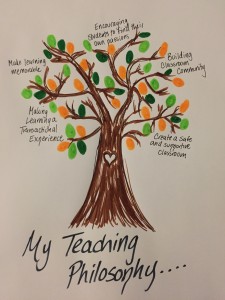Today at Sunnyside was my first formally assessed lesson since November, and overall I feel extremely happy with how it went. My lesson was on Chinese New Year and the significance of Chinese hanging lanterns during this holiday.
I began the lesson by asking students to brainstorm some ideas to several questions I projected onto the board. The students discussed the questions in their small table groups and then recorded their ideas on a worksheet. For the most part I was really happy with how this portion of the activity went because I heard a lot of great ideas being discussed by many of the students; however, after receiving a little bit of constructive feedback, I would slightly change how I presented this task. Next time, rather than giving students the task of discussing and writing down ideas at the same time I would first ask students to discuss their ideas in a group and afterwards ask them to write down some of their ideas. By splitting the task into two separate parts, I think I would get better student participation in the group discussions and also better quality written work afterwards. Once students finished brainstorming their ideas in their small groups we had a whole classroom discussion about the questions. This whole-activity provided each group with the opportunity to share some of the ideas they had discussed in their smaller groups. On the whole, I was really happy with the reactions that some of my questions got from the students, in particular the question: Why does Chinese New Year change dates every year and occur later than our New Year? Although the entire class came up with good ideas as to why, no one was able to guess the correct answer. When I explained to them that Chinese New Year is based off the lunar calendar rather than the yearly calendar all of the students were astonished and you could feel the buzz of excitement within the room. This was a really special moment for me.
Once the students had finished sharing their ideas about Chinese New Year I showed the class a short video about what some common Chinese New Year celebrations look like around the world. It was great to see so many students making personal connections with the images and content they saw within the video. After watching the video we debriefed the clips that were shown and how it related to what we had discussed so far. One student even pointed out how the video showed that Chinese New Year isn’t something that is only celebrated in China, but rather, it is an event that is celebrated all around the world. This is exactly the point I was hoping would be taken away from the video, so I was extremely happy that this student was able to make this connection and share it with the class.
After we finished debriefing the video we moved onto the next portion of the lesson – learning how to make the hanging lanterns. To explain this portion of the lesson I used a couple of students from the class, one of which can sometimes be a little disruptive, to help me demonstrate the steps. I feel that this strategy not only helped me explain the craft more clearly, but it also helped to engage the students and minimize instances of disruptive behaviour in the classroom. Once students understood the different steps involved in making the lanterns, they all began making their own. Time and time again I am so impressed with how helpful the students in my class are. Many students assisted each other while making the lanterns and everyone worked well together, even students who sometimes struggle with working properly together and staying on task. I feel as if this was another really special moment in my lesson.
Additionally, while the students worked I played traditional Chinese music in the background, which I think really set a relaxing and happy tone in the room. Many students even came up to me to tell me how much the enjoyed having the music on while they worked. Based on the student feedback alone, I think that playing music while students worked was a huge success and I will definitely use it again in the future. Overall, I feel it was a great lesson and I was really happy with the end product. The lanterns are now hanging all around the room and they look fantastic!
A few questions that I am beginning to wonder more about as I begin planning for my extended practicum are on the topic of assessment. Lately I feel conflicted about how I should asses each student and how I want to asses each student.
- Should I assess each student based on the standards outlined by the BC ministry of education? OR Should I assess each student based on their individual abilities and successes in the classroom?
- Does it matter which way I choose to assess my class?
- Am I allowed to choose which way I assess my class?
As I continue to work with my practicum class, faculty advisor, student advisor, and UBC professors I am sure some of these answers will start to become more clear, but currently they are very much so on my mind.
